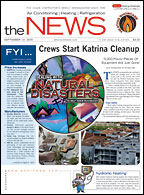
The Federal Emergency Management Agency (FEMA) officially declared Alabama, Louisiana, and Mississippi federal disaster areas the day before Katrina hit. Once the storm had done its damage, FEMA began declaring the areas that were hardest hit eligible for individual assistance and the rest as areas of public assistance. Individual assistance areas (IAA), directly in the path of Katrina, were profoundly affected. Public assistance areas (PAA), though affected, were not as hard hit.
Based on the Heating, Air Conditioning & Refrigeration Distributors International's (HARDI) membership rolls, approximately 36 percent of HARDI member locations in Alabama were located in the IAA. Louisiana's IAA accounted for approximately 70 percent of HARDI member locations. And almost all of Mississippi's HARDI members were located in the IAA.
With an estimated 87 HARDI member locations in the tri-state area, about 60 of them were located in the IAA. Roughly 69 percent of the three states' HARDI members' locations were in the hardest hit areas of Hurricane Katrina.
The HVACR communities started to assess the damage done to the Gulf Coast, both to the systems they work on and the HVACR businesses themselves. Some companies were deeply involved in the grueling restoration work.
"We're running about 20 to 25 people out there who are actually in the field," said John Ferguson, an account executive for Carrier Commercial Services in Jackson, Miss. Evaluating roof safety was done by visual inspections, he said. "There are certain areas, classified zones, that we don't even go into. If water is still standing, we don't go in."
"In contaminated regions, all of our technicians going down there are getting vaccinated for tetanus, typhoid, and hepatitis. We're not wearing HazMat gear, but we are carrying antibiotic stuff with us, wearing shoes, gloves, that sort of thing."

Housing was also a major issue, according to Loren Reid with Munters Moisture Control Services. "The commutes are very bad. Sometimes the commutes are three hours each way. We have been struggling to find accommodations that have power and water. When [crews] get back at night, you don't want to have them in a situation where there's no A/C, water, or showers. That's asking too much of people.
"It's gonna be a long event," he said. "By far it's the worst natural disaster we've ever been faced with. There's going to be a lot of work for a long time. We're working through trying to balance the rest of our business outside of New Orleans. We can't forget about our everyday customers."
In spite of the overwhelming situations and controversies, everyone pitched in to help. North American Technician Excellence (NATE), among others, started a charitable wish list for the nearly 300 NATE-certified technicians in the three Gulf States. They also offered to replace all wallet cards, documents, and patches lost in the hurricane, free of charge.
Publication date: 12/26/2005

Report Abusive Comment